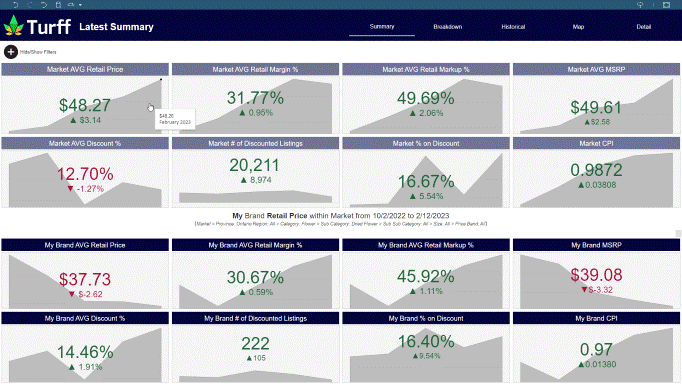23 Jan

How to use My Brand Pricing
Our My Brand Pricing Dashboard is designed to give you a comprehensive understanding of your brand’s pricing strategy. It includes key metrics such as retail price, retailer margin, retail markup, average discount percentage, number of discounted listings, and the percentage of listings that are on discount. Additionally, it also provides data on Current Price Index (CPI), which is a measure of how the retail price of products are calculated in relation to their Manufacturers Suggested Retail Price (MSRP) as it is applied in the market.
The dashboard provides high level snapshots of current pricing trends, month-over-month detail, long-term historical data, a geo-map for postal codes, and a downloadable detailed map. With all this information, you’ll be able to make data-driven decisions to optimize your pricing strategy and improve your brand’s performance.

Key Metrics to Grow Your Brand

Optimizing pricing strategy: By analyzing retail price, retailer margin, retail markup, and average discount percentage, a brand can identify optimal pricing points and make adjustments to their pricing strategy.
Identifying discounting trends: By tracking the number of discounted listings and the percentage of listings on discount, a brand can identify when discounts are being offered and make adjustments to their discounting strategy.
Understanding market trends: By monitoring the Current Price Index (CPI) in relation to their Manufacturers Suggested Retail Price (MSRP), a brand can understand the trends in pricing for their products and adjust their strategy accordingly.
Identifying geographical variations: By utilizing the geo-map, a brand can identify which regions have higher prices than others, which could be useful to understand customer behaviour in those regions.
Comparing historical trends: By using long-term historical data, a brand can compare pricing trends over time and identify patterns to make better decisions about their pricing strategy.
Identifying Postal Codes with high or low prices and make a targeted marketing campaign
Generating detailed data reports: The downloadable detailed map allows a brand to generate detailed data reports and analyze pricing information on a granular level.
The My Brand Pricing Dashboard can provide the data and insight necessary to make data-driven decisions to optimize pricing strategy, and improve overall brand performance. These are just a few examples of the types of questions or decisions a brand may want to make about pricing in the market.
How does my pricing compare to the competition? By analyzing retail price, retailer margin, retail markup, and average discount percentage, a brand can identify how their pricing compares to the competition and make adjustments to their pricing strategy as needed.
Are my products being discounted frequently? By tracking the number of discounted listings and the percentage of listings on discount, a brand can identify how frequently their products are being discounted and make adjustments to their discounting strategy.
How are my prices impacting my sales? By tracking the correlation between pricing and sales, a brand can understand the relationship between their pricing and their products’ performance in the market.
Are there geographical variations in my product prices? By utilizing the geo-map, a brand can identify which regions have higher or lower prices than others, this would allow to better understand customer behaviour in those regions, and how to adapt the pricing strategy accordingly.
How do my prices change over time? By using long-term historical data, a brand can identify patterns in pricing and make adjustments to their pricing strategy over time.
How does the current price index (CPI) impact my prices, and what should be my pricing strategy based on the market trends? By comparing the CPI with a brand’s prices, a brand can measure their product’s price relative to other goods in the market that consumers are purchasing.
How can I make sure my prices stand out in the market? By understanding your target audience, category, and market trends, a brand can make strategic decisions on price differentiation and positioning.
